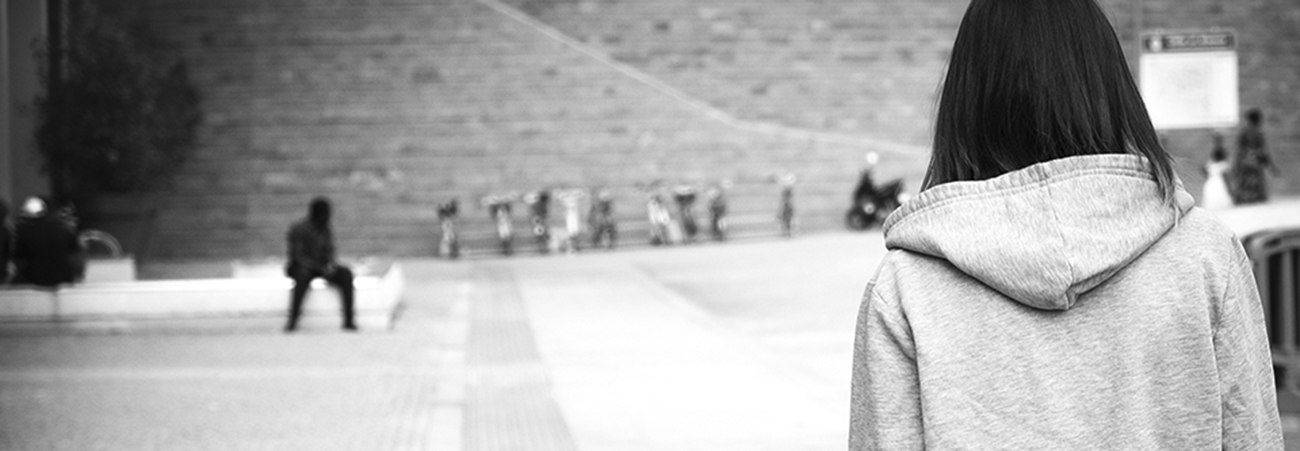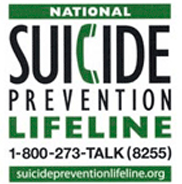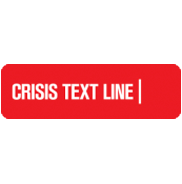

SUICIDE PREVENTION 24/7 HOTLINES

Suicide is a major problem among young people in the United States. It is the third leading cause of death for young people ages 12–18 (Centers for Disease Control and Prevention (CDC, 2007). In a typical 12-month period, nearly 14 percent of American high school students seriously consider suicide; nearly 11 percent make plans about how they would end their lives; and 6.3 percent actually attempt suicide (CDC, 2010).

Any time of day or night, trained counselors are standing by to talk with you if you or someone you care about is having a suicidal thought.

A crisis intervention and suicide prevention phone service. The Trevor Project is the leading national organization providing crisis intervention and suicide prevention services to lesbian, gay, bisexual, transgender and questioning (LGBTQ) young people ages 13-24.

Helps individuals in crisis by connecting them with a compassionate, trained listener through a toll-free texting service. CTL is available nationwide and 24/7. For more information, contact the crisistextline or DOSOMETHING.ORG

The crisis intervention/referral hotline is open every day of the year, day and night, including holidays. Professionally trained and supervised volunteers offer callers telephone support and help them to explore options that can lead to thinking through next steps. We do not offer therapy or advice, but help callers lower their anxiety and find their own solutions. Crisis counselors also provide referrals for support groups, clinicians, mental health clinics, other hotlines and a host of other community programs and services.
RESOURCES
COMPREHENSIVE SUFFOLK COUNTY RESOURCE GUIDE
A guide for aiding parents and children grades K-12 who are dealing with the mental and phhysical impacts associated with bullying.
The National Online Resource for just about everything on bullying, where you can get tips, facts, toolkits and classroom training materials.
PACER National Bullying Prevention Center
PACER is the Minnesota Parent Training and Information Center, funded by the U.S. Department of Education's Office of Special Education Programs. Numerous offerings include: Educator activities and toolkits for all ages, events, activities, outreach, and education. Resources from PACER’s National Bullying Prevention Center make it easy to take action.
Gay, Lesbian and Straight Education Network
The Gay, Lesbian and Straight Education Network is a national organization that seeks to end discrimination, harassment, and bullying based on sexual orientation, gender identity and gender expression in K-12 schools across the U.S. GLSEN features a trove of data, from the THINKB4USPEAK campaign to downloadable K-12 lesson plans, contests, National Climate Survey, peer education, videos and store.
NATIONAL SUICIDE PREVENTION HOTLINE: 24/7 Call: 1-800-273-TALK (8255)
Any time of day or night, trained counselors are standing by to talk with you if you or someone you care about is having suicidal thoughts. The toll-free call goes to the nearest crisis center in their national network. These centers provide 24-hour crisis counseling and mental health referrals.
RESPONSE OF SUFFOLK COUNTY: 24/7 HOTLINE Call: 631-751-7500
The crisis intervention/referral hotline is open every day of the year, day and night, including holidays. Professionally trained and supervised volunteers offer callers telephone support and help them to explore options that can lead to thinking through next steps. They do not offer therapy or advice, but help callers to lower their anxiety in finding their own solutions. Crisis counselors also provide referrals for support groups, clinicians, mental health clinics, other hotlines and a host of other community programs and services.
LONG ISLAND CRISIS CENTER AND RUNAWAY HOTLINE: 24/7 Call: 516-679-1111 for the Middle Earth Hotline Call for live online anonymous counseling. Text “LICC” to “839863” for one-on-one, free, confidential text message counseling (texting is available Monday-Friday from 3pm until 11pm, standard text message rates apply).
“The Long Island Crisis Center provides free, anonymous call in, online, texting or outreach help at any time no matter who you are or what your needs are”. The center provides Crisis intervention, Suicide Outreach Program, L.I. Runaway Hotline, Counseling, Information, Referral, LGBT Pride for Youth Program, Young Latina Initiative and other supportive services to all Long Island residents.
SUFFOLK COUNTY DEPARTMENT OF SOCIAL SERVICES:
THE TREVOR PROJECT
LGBT National 24/7 Hotline
Call: 1-866-488-7386
The hotline is available every day and hour of the year for crisis intervention and suicide prevention phone service. The Trevor Project is the leading national organization providing crisis intervention and suicide prevention services to lesbian, gay, bisexual, transgender and questioning (LGBTQ) young people ages 13-24. Numerous support services and resources can be found.
CORNELL COOPERATIVE EXTENSION OF SUFFOLK COUNTY
Call: 631-727-7850 Ext. 331
M-F 9am-4:30pm
or email tcj2@cornell.edu
Offers educational workshops on bullying and cyber-bullying for parents, after-school staff, camp staff, educators and youth professionals at your location anywhere in Suffolk County. Programs about bullying are also available for parents and school-age children together.
CHILD ABUSE PREVENTION SERVICES OF LONG ISLAND (CAPSLI) Call: 631-289-3240 or 516-621-0552 Office hours: M-F 9am-4pm
For over 30 years, CAPS has been Long Island’s leading organization dedicated to preventing bullying and child abuse. The Bullying Prevention Center offers, among numerous other services, bullying prevention education, staff training, Dignity Act training, Helpline, Volunteer opportunities and the “Students United for Safer Schools” program (SUSS), a bullying prevention peer education program for schools. CAPS now offers to schools the internationally recognized Olweus Bullying Prevention Program, an evidence-based bullying prevention program proven to reduce bullying behavior. CAPS also offers school professionals teaching tools, conferences and staff and faculty development programs on child abuse, bully prevention, Internet safety and sexual harassment, plus NYS Certification Training.
MENTAL HEALTH ASSOCIATION IN SUFFOLK COUNTY INC.
Call: 631-226-3900
or email: info@mhasuffolk.org
This is the premier resource for finding a mental health treatment provider that is the right fit for your needs. Their resource directory (visit their site) and referral service is vast and comprehensive. Their gentle and non-judgmental approach to all things psychiatric includes: educational conferences, workshops and speakers to Suffolk County residents and professionals on a variety of topics related to mental health. They also sponsor a variety of free support groups for consumers and their families.
SUFFOLK COUNTY DIVISION OF COMMUNITY MENTAL HYGIENE
Call: 631-853-8500
M-F 9-5pm for guidance on counseling and prevention services
School and Community Prevention contact: Gail Feldman at 631-853-8506
or email: gail.feldman@suffolkcountyny.gov
Oversees community funded prevention providers (see list below) that offer, free of charge, to all Suffolk County residents and schools, a wide range of prevention programs including: bullying prevention, drug and alcohol overviews, evidence-based life-skills programs, parent and community trainings and coalition building. All workshops and trainings can be tailored to the needs of the individual audience. The “CHOICES” Program and the “Be Somebody” and the “I’m Somebody” peer leadership programs are also available to your school.
SUFFOLK COUNTY CONTRACTED PROVIDERS
Below listed agencies offer free-of-charge prevention workshops and training groups to any school in Suffolk County. Counseling services can be covered by insurance/sliding scale fees. Contact information for each Prevention Specialist is listed.
Alternatives Counseling Center
Linda Huber
Lhuber@alternatives-counseling.org
631-283-4440
Horizons Counseling Center
Elaine Economopoulos
elaineE@tosgov.com
631-360-7578
Eastern Suffolk BOCES
Michael Miles
mmiles@esboces.org
631-289-0078
Family Service League
Lisa Kratzke
kratzke@fsl-li.org
631-399-9217
HUGS
Kym Laube
kym@hugsinc.org
631-288-9505
Pederson Krag
Mary Jane Hudson
mhudson@pedersonkrag.org
631-920-8316
Riverhead CAP
Felicia Scocozza
director@riverheadcap.org
631-727-3722
Click here to watch the "Riverhead Peacemakers" video from CAP
Town of Huntington Youth Bureau:
Huntington Drug and Alcohol
Annie Guthrie
aguthrie@hda.hybydri.org
631-271-3591
West Islip YES
Melanie Holz
MHolz@yesnews.net
631-348-3513
YMCA Family Services
Michelle Schindler
Michelle.schindler@ymcali.org
631-580-7777
SUFFOLK COUNTY OFFICE OF HEALTH EDUCATION Call: 631-853-3162 M-F 9am-5pm or email john.martin@suffolkcountyny.gov
Offers to schools, free of charge, an eight session Peer-Education program entitled “Healthy Communication and Bullying Prevention” for secondary school students. The program, through utilization of improvisation, role plays and group games, teaches participants how to be “Upstanders rather than Bystanders” in their school community and prepares them for presenting in classrooms. Student’s social and emotional coping skills are developed in this training. The Peer Education Program aligns with National Health Education Standards and the NYS Dignity for All Students Act Guidance.
SUFFOLK COUNTY POLICE COMMUNITY RESPONSE BUREAU
Call: 631-852-6109
M-F 8am-4pm
Offers, at no charge, a wide variety of topics for classroom presentations including: Bullying Prevention; Cyber-Law; Distracted Driving; Prescription Drugs to Heroin; Diversity and Acceptance; Tobacco versus Marijuana; Social Host Law; Alcohol and the High School Student.
LONG ISLAND COALITION AGAINST BULLYING (LICAB) www.licab.org Call: 516-777-7709 email: help@licab.org Executive Director: Joseph Salamone
Offers a unique blend of bullying prevention services: Subsidized therapy financially assists families and victims who are in need of third party professional assistance outside of a school environment but are restricted by financial or insurance situations; Youth Leadership Program makes ambassadors in community service of high school volunteers through fund raising and development of leadership and Upstander skills; Smile Packages sent to a bullied individual tailored towards their hobbies, interests, personality, favorite things, in an effort to let them know that they are not alone; School Assistance Programs to create and subsidize anti-bullying programs and assemblies.
LONG ISLAND GAY AND LESBIAN YOUTH (LIGALY) Bayshore: 631-665-2300 East End: 631-899-4950
Offers numerous services for Long Island’s Gay, Lesbian, Bisexual and Transgender youth and their supporters including: school presentations on numerous topics (including tolerance & bullying prevention), support groups, counseling, outreach, volunteer opportunities, testing, workshops, newsletters and more. They provide a safe space for the LGBT youth community ever advocating for equality.
LONG ISLAND PARENT RESOURCE CENTER (LIPRC)
Call: Pamela Mizzi at 631-608-5014
or email pmizzi@NSHS.edu
The LIPRC functions as a centralized clearinghouse of resources for youth, parents, professionals, treatment providers, educators, the media and the general public. They provide this education through a comprehensive continuum of resources, trainings, and community-related services. They serve as a liaison to support coalitions and prevention providers with the integration of prevention science, research and practice.
BIAS HELP Call: 631-479-6015 or toll free Hotline: 1-877-END-BIAS (1-877-363-2427)
Offers to schools the internationally recognized Olweus Bullying Prevention Program, an evidence-based bullying prevention program proven to reduce bullying behavior. BiasHELP, Inc. is a not-for-profit agency dedicated to prevention of bias crimes, hate-crimes, hate-related harassment, bullying, technobullying/cyberbullying and discrimination. BiasHELP’s programs include prevention education, community and school-based technical assistance and support aggressive public policies that ensure human rights protections and effective media responses to current social issues.
ECONOMIC OPPORTUNITY COUNCIL OF SUFFOLK INC. (EOC) Youth and Adolescent Services Call: 631-447-0698 ext 131 Visit our Facebook page.
EOC offers a large variety of services to Suffolk youth and residents. Numerous programs and topics can be presented for schools and agencies including peer education.
NATIONAL EATING DISORDERS ASSOCIATION (NEDA)
HELPLINE: Call: 1-800-931-2237
Monday-Thursday from 9:00 am - 9:00 pm and Friday from 9:00 am - 5:00 pm
NEDA is the national clearinghouse for eating disorder information and body image research. It offers numerous resources including: toolkits, videos, training materials and support. NEDA supports individuals and families affected by eating disorders, and serves as a catalyst for prevention, cures and access to quality care. Be sure to visit their teen activism and confidence building site Proud2bme: An interactive online community created by teens for teens and young adults that promotes healthy attitudes toward weight, food and health.
SUNSHINE PREVENTION CENTER
Call: 631-476-3099
or email Dr. Carol Carter at shine1@optonline.net
Offers a wealth of prevention, community outreach and school training groups particularly in the areas of substance abuse and violence prevention via anger management, teen, social skills and summer programs.
THE GUIDANCE CENTER SERVICES
Call: 631-664-9886
or email Susan Toman at theguidancecenterservicesinc@hotmail.com
Offers North Fork residents a wide array of personalized prevention services including counseling, support, teen empowerment, parenting classes, dances, school programs, the “Lions Quest” program, the “Teen Intervene” Program & coalition building.
Asking Myself Association
Call: 1-631-319-0762
NATIONAL SUICIDE PREVENTION HOTLINE: 24/7
Call: 1-800-273-TALK (8255)
New York State Child Abuse Hotline: 24/7
Call: 1-800-342-3720
If you are deaf or hard of hearing: Call: 1-800-638-5163
National Child Abuse Hotline: 24/7
Call: 1-800-422-4453
National Teen Dating Abuse 24 Hour Helpline:
Call: 1-866-331-9474
or for hearing impaired: TTY: 1-866-331-8453 (7 days/week, 5pm-3am)
National Domestic Violence Hotline: 24/7
Call: 1-800-799-SAFE (7233)
Rape, Abuse and Incest National Network (RAINN): 24/7
Call: 1-800-656-4673
NEW YORK DIGNITY FOR ALL STUDENTS ACT (NYSED):
New York State’s Dignity for All Students Act (The Dignity Act) seeks to provide New York State’s public elementary and secondary school students with a safe and supportive environment free from discrimination, intimidation, taunting, harassment, and bullying on school property, a school bus and/or at a school function. It also was amended to include bullying occurring on digital devices such as cell phones and computers.
FEATURES OF THE DIGNITY ACT:
KNOW THE LAWS
Many states have laws that address bullying. The content of each law varies considerably. Click this interactive map from the STOP BULLYING.gov website for information on each state’s bullying and harassment laws.
There is no federal law that specifically applies to bullying. In cases when bullying is based on race, color, national origin, sex, disability, or religion, bullying overlaps with harassment and schools are legally obligated to address it. You can read more about when bullying overlaps with harassment and how to report it by clicking on the following links:
U.S. Department of Education’s Office for Civil Rights
U.S. Department of Justice’s Civil Rights Division
Centers for Disease Control and Prevention (CDC):
The Youth Risk Behavior Surveillance System (YRBSS) monitors six types of health-risk behaviors that contribute to the leading causes of death and disability among youth and adults, including—Behaviors that contribute to unintentional injuries and violence, Sexual behaviors that contribute to unintended pregnancy and sexually transmitted diseases, Alcohol and other drug use, Tobacco use, Unhealthy dietary behaviors and Inadequate physical activity. Very timely and useful survey data on behaviors of and risks for today’s youth.